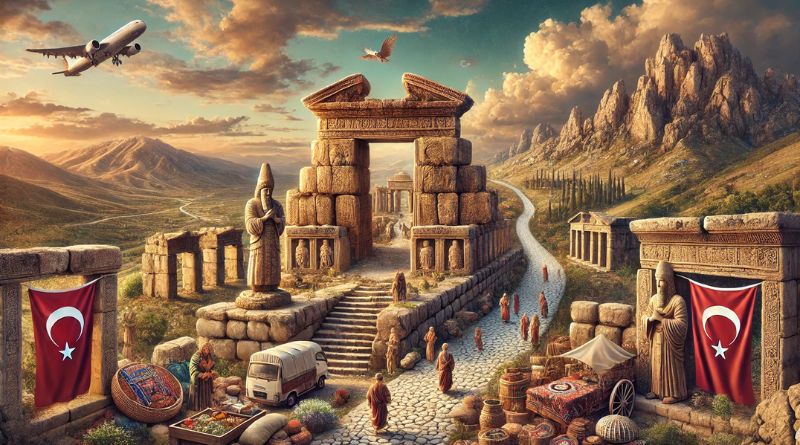Animation is a powerful storytelling medium that can bring to life a country’s culture, history, and traditions in a visually captivating way. When it comes to Turkey, a nation rich in history, diverse landscapes, and cultural heritage, animation provides an exciting way to introduce its wonders to audiences worldwide. In recent years, animated films and series focusing on Turkey have gained attention, highlighting its unique traditions, landmarks, and rich cultural tapestry.
This article delves into the world of animated content inspired by Turkey, discussing what makes it special, how it’s represented in animation, and why this medium is a valuable tool for cultural exploration.
Table of Contents
Turkey in Animation: A Unique Blend of History and Culture
Turkey is a country that bridges Europe and Asia, offering a diverse mix of cultures, historical influences, and natural beauty. From the iconic architecture of Istanbul’s Hagia Sophia to the surreal landscapes of Cappadocia, Turkey’s landmarks and folklore make it a prime subject for animated storytelling.
Why Animation is Effective for Showcasing Turkey
Animation provides a flexible and creative platform to explore Turkey’s:
- Historical Depth: Turkey’s history spans empires such as the Byzantine and Ottoman Empires, making it a fascinating subject for animated series and films that focus on its past.
- Cultural Richness: Turkish traditions, music, and festivals come to life vividly through animation. This includes animated depictions of Turkish folklore, music, and food.
- Beautiful Landscapes: Whether it’s the bustling streets of Istanbul or the scenic beaches of Antalya, Turkey’s varied geography lends itself to beautiful animated settings.
Examples of Animated Content Related to Turkey
There have been several animated films and series that explore Turkey’s cultural landscape or are set in this beautiful country. While these productions vary in style and tone, they all serve to highlight Turkey’s rich heritage and storytelling traditions.
1. The Bad Cat (Kötü Kedi Şerafettin)
This is a Turkish animated film that premiered in 2016. Based on a popular Turkish comic book character, the film tells the story of a mischievous cat named Şerafettin, known for getting into trouble. The movie is set in Istanbul, showcasing the city’s urban landscape in a humorous, action-packed storyline.
2. Children of Heaven (Cennetin Çocukları)
While not as globally known, this animated film touches on Turkish history and the importance of Istanbul as a cultural hub. It explores the life of children growing up in a traditional Turkish household, emphasizing cultural values, family bonds, and the unique spirit of the country.
3. Rise of Empires: Ottoman (Animated Version)
Although primarily a docudrama, some educational animated features are based on Turkey’s Ottoman history, giving a visually engaging way for younger audiences to learn about the rise of one of the most powerful empires in history.
The Power of Animation in Preserving Turkish Folklore
One of the most compelling aspects of Turkey’s presence in animation is the preservation and retelling of traditional Turkish folklore. Turkish legends, such as the story of Nasreddin Hodja, the famous trickster and philosopher, or the tales of the shadow puppets Karagöz and Hacivat, lend themselves well to animated interpretations. These stories, which have been passed down through generations, are brought to life in animation, helping younger audiences connect with their cultural roots.
Folklore Animation Examples:
- Nasreddin Hodja: His witty and humorous tales are often represented in short animated features, making these cultural stories accessible to a global audience.
- Karagöz and Hacivat: Originally performed as shadow puppet plays, animated versions of these stories allow for more elaborate visuals while preserving the comedic and moral lessons embedded in the folklore.
How Animation Enhances Turkey’s Cultural Appeal
Through animation, Turkey’s historical and cultural significance can reach a wider audience, including children, who may not yet be familiar with the country’s rich background. The medium allows for a creative expression of Turkey’s:
- Architectural Marvels: Iconic structures like the Blue Mosque or Topkapi Palace can be explored in detail, with animation highlighting their intricate designs.
- Food and Festivals: Turkish cuisine and festivals, like the Whirling Dervishes ceremony, can be visually stunning when rendered in animated form.
- Traditional Music and Dance: Turkish music, such as traditional Sufi tunes, can accompany animated sequences to give an immersive cultural experience.
Frequently Asked Questions (FAQs)
1. Why is Turkey a great subject for animated content?
Turkey’s rich blend of history, culture, and landscapes makes it a captivating subject for animation. The country’s unique blend of Eastern and Western influences provides a variety of themes, from historical dramas to light-hearted comedies based on folklore.
2. What are some popular animated films or series set in Turkey?
Notable examples include “The Bad Cat (Kötü Kedi Şerafettin),” which humorously explores urban life in Istanbul, and animated adaptations of Turkish folklore, such as stories featuring Nasreddin Hodja.
3. How does animation help preserve Turkish folklore?
Animation offers a modern way to retell traditional Turkish folklore, making it accessible to younger generations and a global audience. Through animated series and films, stories like those of Nasreddin Hodja or Karagöz and Hacivat continue to live on.
4. Are there any international animated films that focus on Turkey?
While most animated content about Turkey is locally produced, there are educational international series that focus on the country’s history and culture, particularly its role in the rise of the Ottoman Empire.
5. How does animation depict Turkish culture?
Animation captures the essence of Turkish culture through vibrant visuals, storytelling, and music. It showcases Turkey’s architectural beauty, historical figures, traditional festivals, and everyday life in its cities and villages.
Conclusion
Animated content about Turkey is a growing genre that offers a visually engaging and culturally enriching experience. From historical epics to humorous adaptations of folklore, Turkey’s cultural richness lends itself well to animation, making it a valuable tool for preserving and sharing the country’s heritage. Whether for entertainment or education, these animated works continue to connect audiences to Turkey’s dynamic and diverse story.

